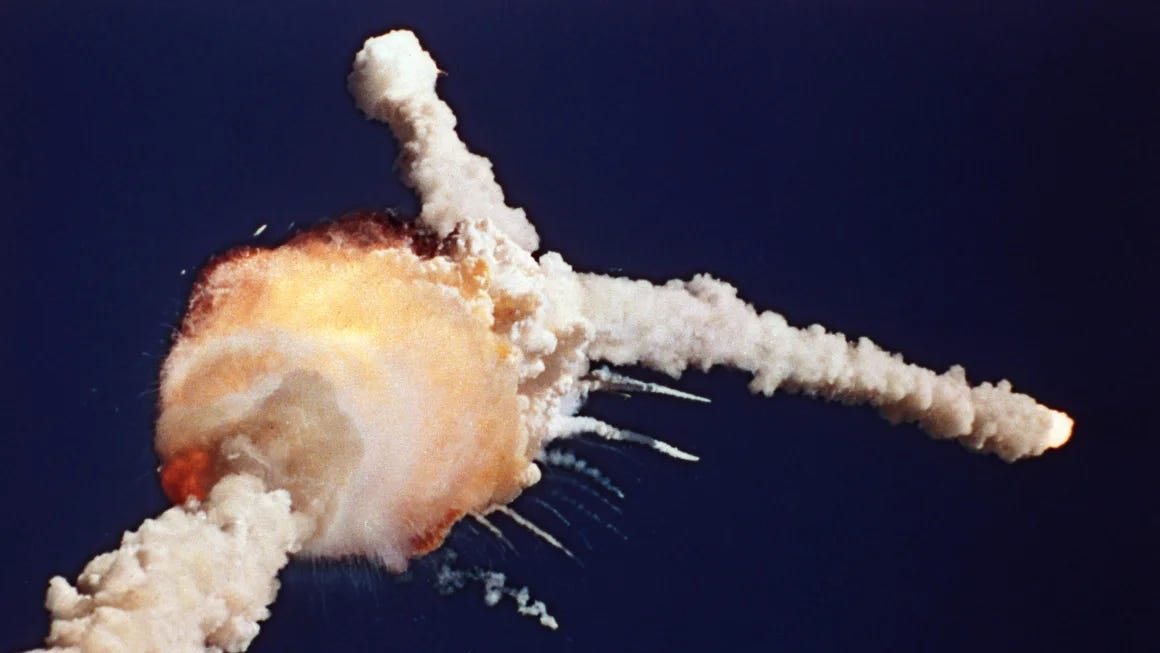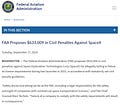SpaceX vs _____: Part 1 - The FAA
A tale of one company's flaunting of the regulations and norms
I fully expect posts in this series to garner a lot of attention from the corners of social media that will defend the actions of Elon Musk and SpaceX no matter what those actions may be. Recognizing that I’m going to need help moderating and addressing the comments, threats, and unsolicited d**k pics experience tells me to expect, I plan to the split income from any subscriptions made on this post with the person who helps me behind the scenes. If you’ve thought about subbing - let this be the post you click the button on.
In this new series, I delve into SpaceX’s recurring failure to follow the rules, regulations, and norms of international spaceflight. I have the receipts, and I hope you will read each article in its entirety before you hit that @ button.
Some background context
It is far from unusual for organizations to create questionable work conditions as they push to increase profits by cutting costs, accelerating timelines, and forcing their staff to do more faster than can safely and accurately be done. What we’re seeing from SpaceX today is not unusual except in so far as they are a rocket company, and as such they have a greater capacity to harm our planet than your average corporation. When we examine SpaceX, it must be in the context of lessons learned from NASA and its past mistakes.
After the Challenger accident in 1986, the Rogers Commission determined that NASA needed new safety features not just on the shuttles, but also built into the organizational handling of future missions because the circumstances of the Challenger accident - launching with a frozen O-Ring - were only possible because of the culture at NASA; a culture that dictated pushing forward even when engineers expressed concerns. Nearly 20 years later, the Columbia Accident Investigation Board would find many of the same cultural issues had arisen within NASA yet again, and they recommended the establishment of an Independent Technical Engineering Authority that would be responsible for technical requirements and all waivers to them.

Ultimately - it was recognized that the old military adage is true, “slow is smooth and smooth is fast.”
And it was recognized that the wolf can’t guard the hen house; independent outside authority is needed to safeguard the processes that safeguard the people and spacecraft.
As I detail in this three-part (for now) series, SpaceX is trying to bypass FAA and EPA regulations on Earth, while flouting FCC licensing around how they broadcast from space. This is happening while company representatives and their hoards of fans suggest SpaceX be made exempt from Federal regulations.
SpaceX isn’t the only commercial space company. From what we’ve been able to determine, Blue Origin, Virgin Galactic, and other US-based companies have been able to launch without incurring fines or triggering investigations other than incident investigations when their spacecraft have blown up. Virgin has been launching largely out of Spaceport America, and Blue Origin is out of Launch Site One in West Texas. Other smaller companies have attempted launches from sites ranging from Alaska to Maine.
In this article, I look at how SpaceX has gone against their FAA launch licenses in Florida. In subsequent articles in the coming days, I’ll delve into their issues in Boca Chica with the EPA, and on-orbit with the FCC and radio astronomy community.
SpaceX vs The FAA
The Federal Aviation Administration governs the operations of all vehicles operating within US airspace. This includes putting forward rules on pre-flight checklists, as well as operations of airport towers and spacecraft control rooms. There are standard procedures for when companies want to make changes, and it doesn’t matter if the changes are being implemented by the local airport that serves crop dusters or the facilities in Florida serving the latest spacecraft; if you want to change how things are flown, the FAA has to approve it.
For many years, SpaceX successfully worked with the FAA to get launch licenses that included approvals of their processes and their facilities (launch and control sites). Things changed, however, in 2023, with 2024 becoming the year SpaceX faces FAA penalties.
On May 2, 2023, SpaceX formally requested changes to its preflight checklists and Florida control center. Specifically, they asked to:
skip their T-2 hours readiness poll, and
switch from using their Launch Control Center in Building 90327 of the Cape Canaveral Space Force Station or their Launch Control room in the NASA Kennedy Space Center Facility K6-0900, and to instead use the Hanger X control center.
Per the FAA’s Notice of Proposed Civil Penalty (Case No. 2023WA990028), the FAA informed SpaceX of the following:
June 15, 2023: The FAA would not approve SpaceX's proposed new communications plan before a scheduled June 18, 2023 launch; and
June 16, 2023: The FAA would not issue a modification to SpaceX's license before a scheduled June 18, 2023 launch.
This should not have posed SpaceX any difficulties: they had an existing launch license that would allow their planned flights using the T-2 hour poll and existing control center or control room.
Nevertheless, SpaceX went ahead and used the new control center and launch procedures during their 18 June 2023 Falcon 9 PSN MFS Satria mission.
It is unclear why SpaceX chose to make these procedural changes, or why they couldn’t have filed their paperwork earlier. They allotted the FAA less than 60 days to review their submission. For comparison, passports take 6-8 weeks to process.
This kind of short fuse request to the FAA would occur again, just a few weeks later. On 19 July 2023, SpaceX requested a revised launch license for their Falcon Heavy that would reflect their construction of a new rocket propellant farm. (Specifically, they were updating their Explosive Site Plan ). This request went in 9 days before a planned launch. Per the FAA’s Notice of Proposed Civil Penalty (Case No 2023WA990031):
On July 26, 2023, the FAA informed SpaceX that the FAA would not approve a
modification to SpaceX's launch license to permit a new [rocket propellant farm] prior to a scheduled July 28, 2023 launch.
Again, SpaceX had a permit for their old setup. Again, they didn’t give the government ample time to approve their new setup. And again, they launched anyway. On 28 July 2023, SpaceX launched the Falcon Heavy Echostar XXIV/Jupiter 3 mission using the new, unlicensed, propellent farm.
Between the two FAA Proposed Civil Penalty filings, SpaceX is being fined $633,000, with the FAA sending a clear message: SpaceX needs to act with the utmost concern for safety and for following the rules. The FAA has documented SpaceX breaking the following parts of the Code of Federal Regulations (quoting from filings linked above):
14 C.F .R. § 417 .111 (a), which states that the launch operator must follow each
launch plan;
14 C.F.R. § 417.1 l(a), which states that a launch operator must conduct a licensed launch and carry out launch safety procedures in accordance with its application.
14 C.F.R. § 417.9(c), which states that for a launch from an exclusive-use site,
where there is no licensed launch site operator, a launch operator must satisfy the
requirements of this part and the public safety requirements of part 420 of this
chapter.
14 C.F.R. § 417.417(b)(2), which states that a launch operator must ensure that only those explosive facilities and launch points addressed in the explosive site plan are used and only for their intended purposes.
14 C.F.R. 420.63(a), which states that except as otherwise provided by paragraph
(b) of this section, a licensee must ensure the configuration of the launch site
follows its explosive site plan, and the licensee's explosive site plan complies
with the requirements of§§ 420.65 through 430.70.
Here are links to the guidelines: 14 C.F.R 417 - Launch Safety, and 14 CFR 420 License to Operate a Launch Site.
To reiterate, for both the 18 June and 19 July 2023 launches, SpaceX could have operated under existing licenses. It was their own impatience and/or inability to file paperwork with sufficient lead time that caused them to be fined.
SpaceX seeks to be above the regulations, but…
A search of Twitter/X on the terms elonmusk and FAA reveals calls for the FAA to get out of SpaceX’s way. Elon Musk has said, “It should be possible to build a giant rocket faster than paper can move from one desk to another.” Musk is calling for the director of the FAA to resign, and his followers are making it clear they feel the FAA’s policies and procedures are nothing more than bureaucratic red tape (with some saying it is being weaponized against Musk).
Throughout these tweets is a recurring theme: SpaceX has so far been safe, and SpaceX’s style of iterative design is incompatible with the government’s current regulatory system. Let’s look at each of these.
Yes, currently, SpaceX has the best launch safety record of any launch provider. This track record is due in part to the sheer number of launches their reusable rockets enabled in just a few years. It is easier to erase the statistical impact of early failures when you have a large numbers of later successes. This track record also reflects their actions while following the same federal guidelines they now seek to ignore. Logic does not allow us to assume their launch safety record will stay the same if an outside body isn’t providing an independent assessment of safety procedures. Their track record (2023 story, 2024 story) of poor employee safety (worse than industry standards) provides us with another data point that indicates SpaceX will risk harm to achieve its goals.
SpaceX is building and operating rockets that could easily become ballistic missiles, bombs, or environmental catastrophes. Claims that the FAA is only getting in the way of rapid-fire iterative design require one to believe that no SpaceX engineering team will fail to think of a possible failure mode or will suggest something with negative unintended consequences. The FAA takes time to process requests because 1) they have to handle a lot of requests not just from SpaceX, and 2) they take the time needed to verify dumb ideas, unsafe ideas, and ideas with unintended consequences don’t move forward and destroy something.
In order for SpaceX to give FAA the best possible chance of approving their newest ideas before they want to use them in a launch, it behooves SpaceX to hire the staff needed to start filing paperwork the moment they start purchasing / contracting whatever that new idea requires. More than nine days transpired from SpaceX conceiving of a new propellant farm to them launching using a new propellant farm, but they only gave the FAA 9 days to make approvals.
We must learn from the past to protect life and our planet
I started this article with a reminder of the Roger’s Commission and Columbia Accident Investigation Board findings: accidents occur with organizational safety is insufficient and when outside independent review isn’t present.
SpaceX has accomplished great feats of engineering (although, like other companies, they have a track record of always delivering years late). They are counted on to deliver humans to space and space probes to Earth-orbit and beyond, and have shown they are so far capable of the job.
We still must ask, why has SpaceX ignored regulations and will its past trespasses create the circumstances for future space accidents?
As a journalist, it isn’t my responsibility to tell you what should or shouldn’t happen (although I have personal opinions), but I am obliged to point out history, provide context, and report facts. I ask you to use this information to decide for yourself if SpaceX, or anyone else, should be above the law … especially when they are launching vehicles capable of blasting a hole in the ionosphere.




